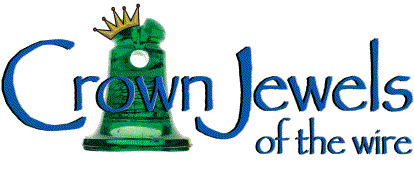Porcelain Telephone Signs
by Alan Colburn
Reprinted from "INSULATORS - Crown Jewels of the Wire", November 1984, page 11
Porcelain Bell Telephone signs have been around since 1888, when Angus S.
Hibbard, then general superintendent of AT&T, designed the first AT&T
logo, a large blue bell with the words "Long Distance Telephone" (see
drawing). It appeared on the first porcelain Bell signs soon afterwards. These
first signs, as well as other early porcelain signs were made in England.
This style was replaced with the type in photo 1 about 1895. The words
"Local and" were added to the bell at this time. These signs often
said "Telephone Pay Station". The sign at top in this photo is 8"
x 18", is worded on both sides and has a flange for mounting. Bottom left:
This sign is flat, 15-3/4 x 19-1/2 and two-sided. Right: 17 x 18, also two-sided
with a flange.

Photo 1.
In 1908 the words "American Telephone & Telegraph Co." were
added around the top of the bell in an arc, and the words "And Associated
Companies" was put in the lower arc (photo 2). The words "Bell
System" were used for the first time in 1908. The top left sign is 18 x 18,
the top right
is 16 x 16, and the bottom sign is 11 x 16. All of these are two-sided and
have flanges. The bottom sign also came in a style with the word "Booth' in
the open space at left. It is much harder to find.

Photo 2.
Next came the major design change of 1921 (photo 3). "Local and Long
Distance Telephone" was dropped from the bell and replaced with the words
"Bell System". These signs usually said the individual Bell company
name at the top of the arc, and the usual "American Telephone &
Telegraph Co." at the bottom.

Photo 3.
Top row, L-R: 5-1/2 x 19, one-sided (This
type of sign also came two-sided with an arrow.); 8 inch round concave, one
sided (There are several styles.); 14 inch round, two-sided with a flange (There
is also an 18 inch style.). Bottom, L-R: 16-1/2 x 19, two-sided, no Bell company
name; 16 x 16, two sided with flange (This New England sign is common.); 11 x
11 (actually 11 x 11-3/4), two-sided with flange (This style is probably the
most popular among telephone sign collectors. Some specialize in this type. Also
on title photo.).
Around 1939 the telephone signs changed again (photo 4). Notice how the bell
has changed. Top row, L-R: 11 x 11, two-sided with flange (This is the most
common telephone sign.); 18 inch round, two-sided and flanged (This sign is also
common.); 5-1/2 x 12, flat two-sided, common. 2nd row, L-R: 16 x 16, just like
the one above it, very common; 7 inch round concave, one-sided, a little less
common; 20 x 20, flat two-sided, which is a little harder to find. Bottom: 8-1/2
x 34-1/2, two-sided flat, also common, this sign hung from a bracket.

Photo 4.
Photo 5 is of independent telephone company signs. With the exception of the
middle and bottom left signs, these are newer and have a thinner porcelain
coating. Some are made of aluminum. Most telephone sign collectors won't pay
much for these, if they even want them.

Photo 5.
The Bell Telephone Company of Canada also used telephone signs similar to
AT&T, but their signs still said "Local and Long Distance
Telephone" up to around 1947, while AT&T dropped that about 1921.
The signs pictured in this article are some of the ones in my collection. I
will answer any questions you may have about telephone signs.
Alan Colburn, NIA #2200
1616 N. "N" St.
Lake Worth, FL 33460
| 